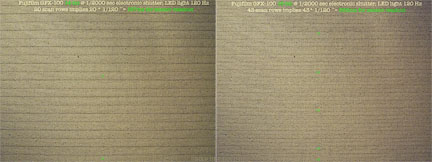EXCERPT page containing first few paragraphs. 2024-04-18 02:12:38
UA_SEARCH_BOT_null @ 3.133.154.106
For full access, subscribe here. Or click title to login. ![]()
Striping from Electronic Shutter with Artificial Light
Digital sensors take time to read out (excluding the still rare global shutter sensors). The sensor is read in bands, and the time it takes to read the entire sensor is called the sensor readout transit time.
It doesn’t matter if the “shutter speed” is 10 seconds or 1/10 second or 1/2000 second or even 1/16000 second—the camera will take the same amount of time to read out the sensor data.
The shortest possible transit time is desired, but as of 2020, transit times even on the fastest 35mm cameras are still quite long in duration, for example 100ms range (1/10 second) for the Sony A7R IV. In general, lower resolution cameras and fewer bits per pixel mean a faster transit time.
Article continues for subscribers...
Diglloyd Making Sharp Images is by yearly subscription. Subscribe now for about 13 cents a day ($50/year).
BEST DEAL: get full access to ALL 8 PUBLICATIONS for only about 75 cents a day!
Diglloyd Making Sharp Images articulates years of best practices and how-to, painstakingly learned over a decade of camera and lens evaluation.
Save yourself those years of trial and error by jump-starting your photographic technical execution when making the image. The best lens or camera is handicapped if the photographer fails to master perfect shot discipline. High-resolution digital cameras are unforgiving of errors, at least if one wants the best possible results.
- Eases into photographic challenges with an introductory section.
- Covers aspects of digital sensor technology that relate to getting the best image quality.
- Technique section discusses every aspect of making a sharp image handheld or on a tripod.
- Depth of field and how to bypass depth of field limitations via focus stacking.
- Optical aberrations: what they are, what they look like, and what to do about them.
- MTF, field curvature, focus shift: insight into the limitations of lab tests and why imaging performance is far more complex than it appears.
- Optical aberrations: what they are, what they look like, and what to do about them.
- How to test a lens for a “bad sample”.
Intrigued? See Focusing Zeiss DSLR Lenses For Peak Performance, PART ONE: The Challenges, or (one topic of many) field curvature.


